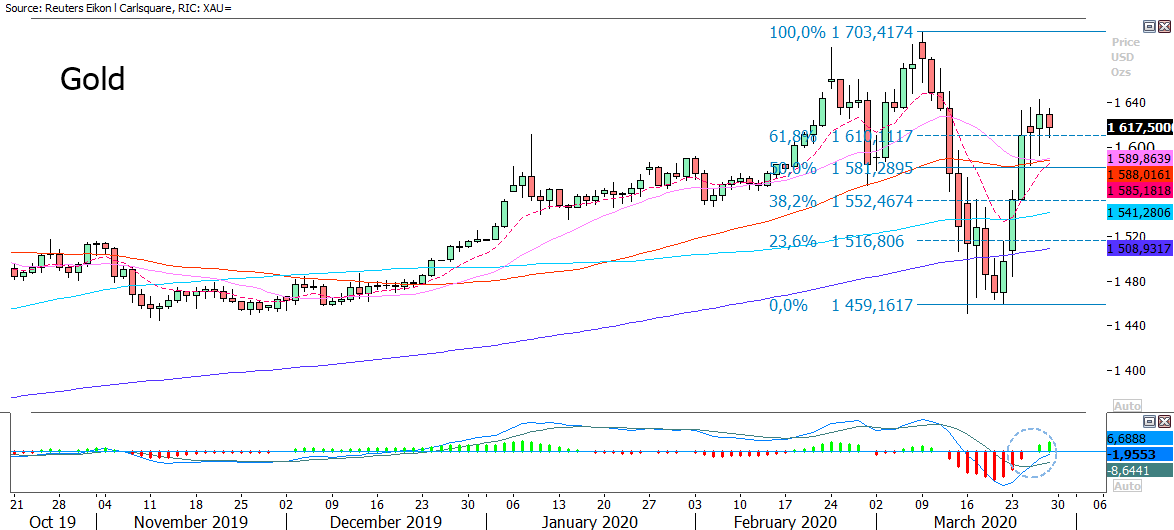Where are the central banks´ money going?


Last week´s trading offered a good bounce on the stock markets. The states are now competing to support the underlying economy in order to deal with the enormous effects of the countries gradually being shut down to hinder the spread of Covid-19.
Last week´s trading offered a good bounce on the stock markets. The states are now competing to support the underlying economy in order to deal with the enormous effects of the countries gradually being shut down to hinder the spread of Covid-19.
The number of infected persons continues to increase but may begin to flatten in Italy. However, the lack of tests creates great uncertainty in the data:

Looking at the number of deaths in different countries, it is difficult to see any real difference between the western countries:

Note that most countries are just in the early phase of the rapid growth in number of cases:

The countries that stand out on the positive side are Asian countries such as Taiwan, South Korea and Singapore. It is far too early to draw any conclusions whether the actions taken by the governments in Germany, the United Kingdom or Sweden are right or wrong to the fight the disease. The death rate of Covid 19 seems to be around 1 percent of those infected in countries that has managed to keep the spread of disease under control to a degree where the health care systems are still functioning. It is 5-10 times higher death rate than a common flu which in no way implies the end of humanity. Those countries that can control the spread of the infection to an extent where the health care succeeds in managing the sick – those are the countries that will come through this crisis first and foremost.
Although the Asian countries on paper appear to be superior in this fight, we are not sure that they are doing the right thing. They hold the infection back to a maximum, which also means that it will take years for the populations in these countries to achieve immunity. Assuming that a vaccine can be created in near future, this is the right path. But we still see no breakthrough in the vaccine field. In a worst-case scenario it may take a year before an approved vaccine is here.
As we have said before, we have begun to swing more and more towards not to forget the underlying economy in the fight against the Corona virus. The recession is also damaging to public health.
The economies are in free fall and we only should wait for a tsunami of bad news in near future. In order to remedy this, the central banks and the states have instead opened the cranes on at the end to counter the sharp decline.
The red line in the graph below is the S&P 500. The blue line is the Fed's balance sheet. In one week, the Fed's balance sheet has increased by as much as the entire Q1 round in 2009. But this seems to be just the beginning as many expect the Fed's balance sheet to double in 2020:

Below is a compilation of the financial stimulations in various forms activated by various states to fight the economical effects of the Corona outbreak. Note that the scale is support in relation to the countries' total GDP.

No one knows how the financial stimulation will affect the countries' economies in the long run. But one thing is certain. The United States is fast moving in the direction of Japan, where the central banks hold an absolute majority of outstanding government bonds. That is: the state debts are an asset at the central banks. Somewhere along the way, this will create an unsustainable situation. Either way it leads to a capitalist form of socialism where everything is owned by the state. Otherwise there could be a situation where a new Maynard Keynes sits down and looks at the balance sheets and suggests a new model. The only straightforward way to handle this would be that the central banks write down their claims on the states to 25 percent as in any corporate restructuring. In this way, negative interest rates can be is in the past and the economies can start to function again. The risk of deflation is otherwise imminent… But this is a discussion for the future. Now it is important to take a day at a time.
The states pumping money into the system may not realize that someone should receive that money. Ideally, companies may receive them in the form of loans. But it is only those already heavily indebted who want additional loans in times of crisis. Those who generate earnings and have a stable cash flow do not want to put themselves in debt because it adds interest costs.
The Fed is gradually widening its purchases from government bonds to housing bonds and last week also to corporate bonds. The first line of defense is to keep banks and indebted companies under arms. But the economy will not gain momentum without the purchasing power increasing everywhere. It is therefore only a matter of time before the helicopter money will come, that is, direct contribution to the purchasing power of the consumers. If the sum of the helicopter money is just the net of what is lost in purchasing power due to rising unemployment, thus will be a zero-sum.
But this will soon come as a letter in the post, so it is important to keep track of how the markets will react on this. So far, only grocery stores, pharmacies, network doctors and some medical device manufacturers are the winners. However, Internet traffic is also a winner, so IT will be one of the first sectors to snap back. Housing prices are intimately linked to unemployment, so this market will take a hard hit. The whole trend of leasing office hotels like WeWork and Swedish Convendum is getting a real thorn, even though we believe in the concept is viable in the long term.
WeWork has not listed its stock but its bond has fallen sharply in value:

The other major recipient of liquidity is the listed markets. The huge support purchases spill over the capital stock markets. In Japan, the Bank of Japan is already buying shares through exchange-traded funds (ETFs). The Fed is dangerously close to this limit when entering the corporate bond side. President Trump has every reason to applaud this development because at any cost he seems to want to keep the S&P 500-index above the level where he was elected President of the United States. Otherwise, he has a hard time to become re-elected.
So, there are enormous forces in movements. The outlook for the underlying economy screams for the equity investor to be 100 percent liquid. But the huge support money that central banks and countries throw into the system works in the opposite direction.
One thing is certain though, all fundamental analysts who look at PE-figures have already missed the downturn and have also missed the bounce back up. Corporate profits are not what is driving the stock markets right now. It is the availability of liquidity and the supply and demand for shares which is the real driving force for the stock market. Since we do not have access to the internal information of the central banks, we have to settle for studying the graphs.
From the stock exchanges perspective, the S&P 500-index has fallen by 35 per cent and then risen 20 per cent from that new level.

As shown in the weekly graph above, resistance is found around the 2 650-level. Note in the daily graph below a falling MA20 that is meeting up around the same level but how MACD also has generated a weak buy signal:

MACD has also generated a weak buy signal in the daily graph for Nasdaq. Again, a declining MA around 7 830 needs to be broken before the short trend has turned positive:

In Europe, the stock markets have developed a similar pattern to the movement in the US. Below the OMXS30-index is shown. As can be seen, a falling MA20 needs to be broken for the short-term trend to turn positive. MACD has generated a weak buy signal:

Interesting is that the Sandvik share is trading above MA20 and EMA9 is rising thereby supporting the stock from under. Fib 38.2 still serves as resistance:

The DAX index closed Friday´s trading on a support level in form of EMA9 and Fib 23.6, just like OMXS30. MA20 meet up as a first resistance at 10 050. MACD works in favor of further upwards movement:

Looking at interest rates, they have again imploded. Now the 10-year yield in the US is back below the one percent level:

The development of the USD is key to the future. After an extreme upturn in the pair EUR/USD below, there was a technical bounce. On Friday, the currency pair also managed to close above Fib 50 and MA200. The next level on the upside can be found around 1.116:

As marginal calls have come to an end for this time, the Gold price has gained momentum as the USD has fallen:

As can be seen, the gold price closed above Fib 61.8. Can a continued weakness in USD get gold to test precious top from early March?
Bitcoin has broken below a rising trendline and both EMA9 and MA20 is falling. The next level on the downside can be found around 5 675 and 5 420:

Risks
This information is in the sole responsibility of the guest author and does not necessarily represent the opinion of Bank Vontobel Europe AG or any other company of the Vontobel Group. The further development of the index or a company as well as its share price depends on a large number of company-, group- and sector-specific as well as economic factors. When forming his investment decision, each investor must take into account the risk of price losses. Please note that investing in these products will not generate ongoing income.
The products are not capital protected, in the worst case a total loss of the invested capital is possible. In the event of insolvency of the issuer and the guarantor, the investor bears the risk of a total loss of his investment. In any case, investors should note that past performance and / or analysts' opinions are no adequate indicator of future performance. The performance of the underlyings depends on a variety of economic, entrepreneurial and political factors that should be taken into account in the formation of a market expectation.